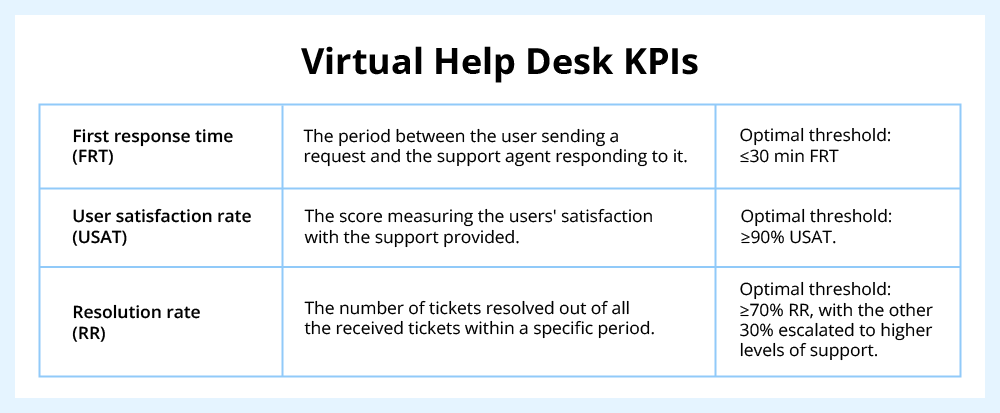Virtual Help Desk
Setup Guide
In IT help desk services since 2007, ScienceSoft describes how to organize a virtual help desk and shares the best practices that are based on our experience in managed and co-managed remote support services.
Virtual Help Desk Summed Up
The purpose of a virtual help desk is to handle user issues and requests regardless of where users or support staff are located. While it may utilize AI tools, a virtual help desk is not run entirely by virtual AI agents. Instead, it is managed by a distributed team of people connected virtually. Typically, a virtual help desk is outsourced.
- Time to set up: around 2–4 weeks to launch an outsourced help desk.
- Team: a team lead, a project manager (optional), help desk agents.
- Pricing: virtual help desk costs vary depending on the required support levels, monthly ticket volume, and time coverage. For example, if outsourced, the costs range is about $7–$16 per L1 ticket and $32–$46 per L2 ticket.
Learn about the possible pricing models (subscription fee, T&M, per-user, price per ticket), or use our free online calculator to get a ballpark estimate for your case.
Help Desk Delivery: Virtual vs. Onsite Teams
|
|
Virtual Help Desk |
Onsite Help Desk |
|---|---|---|
|
Location
|
Agents work from multiple geographically dispersed locations. This model can reduce expenses on physical office infrastructure. |
A centralized team of people works in shifts from a single location. Communication is easier, but the setup requires extra office infrastructure. |
|
Time coverage
|
The virtually connected team can be split into different time zones to provide services at any time. |
Even though 24/7 coverage is possible, in-office teams may face challenges like staff shortages and burnout. |
|
Technology dependence
|
It requires a cloud-based infrastructure and support solutions enabling more complex routing, escalation, and workflow automation. |
Onsite help desk doesn’t require cloud services and can rely on the on-premises infrastructure and in-person collaboration. |
|
Use case
|
A virtual help desk provides high scalability and is commonly used by companies with globally dispersed teams. This model is especially suitable for remote or hybrid work setups since even onsite agents wouldn’t be able to support remote users physically. |
The onsite help desk is suitable for companies that rely on direct access and localized troubleshooting of on-premises systems. This model offers simplicity in utilized technologies and allows for offline knowledge exchange or hands-on repairs. |
How to Organize Virtual Help Desk

Stage 1.
Scoping
For any kind of help desk, it’s imperative first to define the scope of work, including:
- Types of users (employees, customers, or both) to support.
- The estimated number of monthly requests.
- Types of requests (e.g., incidents, bugs, change requests, software usage issues, requests for information).
- Request priority (how big is the share of urgent tickets that need to be resolved on the same day or faster).
- Any planned IT initiatives that will put an extra load on the help desk in the near future (e.g., switching all users from personal to corporate devices or migrating to a new cloud app).
Stage 2.
Planning
- Based on the specific support needs and scope, determine the time coverage (e.g., 24/7, 12/5, 12/7, 8/5, after-hours support), the help desk tiers (L1 — user support, L2 — technical support, L3 — software engineers), and the size and composition of the help desk team. Small teams usually only need one team lead. For large teams working on multiple dedicated apps or projects, you may need several team leads and a help desk manager to coordinate their efforts.
- Define the communication channels through which users can reach the help desk. They may include:
- Self-service portals.
- Service desk software.
- Email.
- Phone.
- Instant messaging apps.
- Social media.
- Document the help desk processes, including:
- Standard operating procedures (SOPs) for incident management, change management, and other aspects.
- Ticket processing workflows detailing ticket creation, prioritization, processing, and resolution processes, as well as user notification about the ticket’s status.
- Issue escalation protocols.
- The format and frequency of reporting on the support activities (e.g., service level reports, maintenance reports, health check reports, security reports, incident reports with root cause analysis).
- Identify virtual help desk KPIs that will be monitored. Here is an example of KPIs that ScienceSoft typically tracks:

Depending on the help desk specifics, other metrics can include average time to resolution, call abandonment rate, or mean time to recovery.
- Define the tools necessary for setting up a robust virtual help desk.
Ticketing system
A ticketing system is the backbone of efficient support service. It provides your virtual desk agents with a convenient workspace to track tickets, access incident details, and manage IT support processes.
Examples
Remote support software
Remote support software allows virtual help desk agents to quickly connect to remote end-user devices (desktops, smartphones, tablets, etc.) and provide reactive and proactive support.
Examples
Video conferencing tools
Video conferencing tools enable easy real-time communication between users, onsite technicians, and remote support agents.
Examples
Security tools
Security tools protect your remote collaboration setup from cybersecurity threats. You can implement multi-factor authentication (MFA) to prevent unauthorized access, anti-virus software for endpoint protection, a VPN enabling access to the corporate network via a secure encrypted tunnel, and other security controls depending on your infrastructure.
Examples
Automation tools
ITIL promotes standardizing and automating the resolution of recurring issues as well as the fulfillment of repeating service requests. For example, tasks such as software installation or provision of virtual servers can be fulfilled entirely by automation.
Examples
Self-service portals
Virtual help desks rely heavily on self-service portals. Out-of-the-box and custom self-service portals benefit from a comprehensive, easy-to-navigate service catalog and knowledge base.
Examples
AI chatbots
AI chatbots can help log and resolve trivial user requests in no time, effectively decreasing the ticket volume handled by human agents, and are available 24/7.
Examples
The list above is not definitive and covers only the key tools needed for the effective collaboration of a distributed team. It can be complemented with infrastructure monitoring software like Zabbix, Nagios, or QRadar. If you are still unsure about the fitting virtual help desk software, we provide consultations for organizations of any size, from small businesses to enterprises. Our experts assist with selecting virtual help desk tools as well as other aspects, like carrying out feasibility studies (calculating ROI and TCO of virtual help desk, analyzing workflow efficiency, etc.).
Stage 3.
Launch and management
If you opt for outsourcing a virtual help desk to one of the best help desk providers, sign an SLA containing the service description and scope, KPIs, reporting frequency, and other key collaboration aspects.
After the knowledge about the target IT infrastructure, software, and processes is transferred to the outsourced team, the virtual help desk is ready to be launched.
As the support engineers continually process requests and issues, they analyze and eliminate incidents’ root causes and suggest improvements to prevent repeat issues.
Step 4.
Optimization
Continuously optimize help desk workflows as a result of:
- KPI monitoring and process review and improvement.
- Updating the knowledge base for agents and users.
- Gathering and analyzing user feedback.
- Automating repetitive tasks and standard processes.
Explore How Virtual Distributed Teams Excel at Help Desk
33 results for:

24/7 White-Label L1 Support for Delap LLP
For nine months, ScienceSoft provided white-label L1 help desk services to Delap LLP, an established US financial services firm and MSP. By promptly resolving 60% of all the tickets from five of Delap's clients with a 7-minute FTR, we freed up its in-house L2 and L3 support teams.

L1 Support for Qventive Healthcare with 90%+ Resolution Rate and Significant Cost Savings
For nine months, ScienceSoft has been providing 24/7 L1 support to Qventive Healthcare’s clients. Our team efficiently handled an average of 100 tickets per month, ensuring a 30-minute FRT for email requests and a 20-second FRT for calls, with an average TTR of 20 minutes.

L1 Support for ScribeAmerica
ScienceSoft delivers 12/5 L1 support for ScribeAmerica, one of the largest medical scribe companies in the United States with over 25,000 employees. Our team handles around 500 average monthly tickets with a 7-minute first response time.

L1-L3 Support for System One, a 9,000-Employee Company
For over three years, ScienceSoft has delivered L1–L3 support to System One, an international provider of outsourced services and workforce solutions.

L2–L3 Infrastructure Support for BPC
ScienceSoft provided L2–L3 infrastructure support for BPC, a fintech company delivering digital banking, payment, and ecommerce software products. BPC managed to cut IT support expenses by 10%+ while ensuring the fail-safe performance of its network and IT systems.

24/7 L1 Support for Lolli & Pops Results in 100% User Satisfaction
For a year, ScienceSoft has provided 24/7 support to Lolli & Pops, a premium confectionery chain of 70+ stores. Our team handles 400 cases a month with a 30-minute FRT, resolving access issues, troubleshooting basic network problems, and administering retail software.
ScienceSoft as a Global IT Support Partner
- 17 years of experience in help desk services.
- 16 years in ITIL-compliant ITSM.
- 62% of our revenue is coming from clients who stay with us for 2+ years.
- 4,000 projects successfully carried out in 75+ countries across the Americas, Europe, the Gulf Cooperation Council (GCC), Asia, and Oceania.
- Multilingual IT specialists proficient in English, Spanish, German, French, Polish, Turkish, Czech, and other languages.
What makes ScienceSoft different
Proactive Help Desk: Fewer Issues, Lower Costs
Proactivity is at the core of our approach to help desk delivery. We not only maintain IT stability but also recommend improvements leading to fewer tickets reported, higher user satisfaction, and optimized help desk costs.















